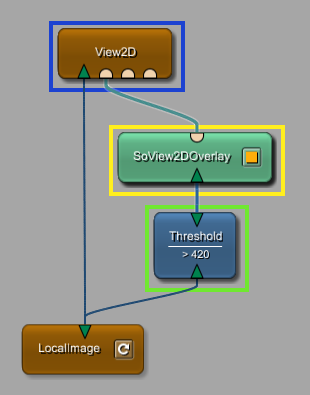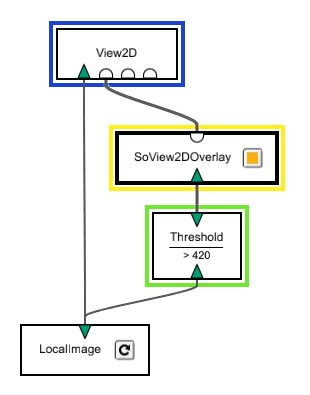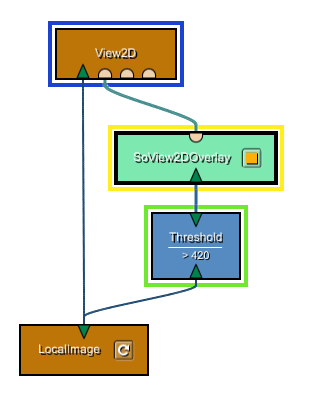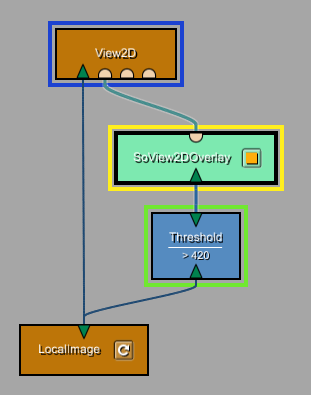| 4.3. Preferences | ||
|---|---|---|
 | Chapter 4. Menu Bar |  |
![[Note]](images/note.png) | Note |
|---|---|
Settings in the Preferences
panel overwrite the corresponding settings in the |
The Preferences (along with other information, such as the list of recent files or stored user layouts) are saved in a manner that prevents them from being overwritten during updates or reinstallations of MeVisLab:
On Windows: in the
Registry in Workstation/HKEY_CURRENT_USER/Software/Mevis/MeVisLab.
On Mac OS X: in $HOME/Library/Preferences/de.mevis.MeVislab.plist.
On Linux: in $HOME/.config/MeVis/MeVisLab.conf.
![[Tip]](images/tip.png) | Tip |
|---|---|
For many options in the Preferences, a mouse-over tooltip is available. |
User Name
The user currently signed in to this computer.
Resources
The optimal Resources settings depend on the system and platform. Use the default settings if uncertain.
Image Processing
Image Processing Cache Size (MB)
Defines the memory available for caching (intermediate) ML image tiles/pages within a network of image processing modules. Reducing the cache size will slow down the image processing pipelines because images will be recalculated more frequently in individual modules. Cache sizes too large might cause a collapse of your system because of reduced memory for other programs. For 2 GB RAM, a value of 512 MB is well-tested. For details, see the ML Programming Guide, “Optimizing Data Flow in Module Networks.”
Use classic ML host
If checked, the classic ML host is used. Otherwise, an ML host is used that implements an optimized multi-threading for the ML.
GVR Visualization
Total Texture Memory on Graphics Card (MB)
Sets the amount of texture memory (texture RAM, TRAM) on the graphics card to be used for MeVisLab texture processing, for example, in the View2D module.
Volume Renderer Texture Cache Usage (%)
Defines the percentage of texture memory that the GVR volume renderer may use.
Maximum Number of Threads Used for GVR Processing
Sets the number of parallel threads for GVR processing. For more details on multi-threading, see Section 28.6, “Multi-threading in MeVisLab”.
Background Tasks
Maximum Number of Background Worker Threads
Set this to 0 to use the number of virtual cores of the system.
IDE Options
Auto reload files when changed
If selected, the .def, .script, and .py files of a module are
reloaded when reloading the module panel (by double-clicking the module or
selecting Show Window → Panel from the module context menu).
![[Note]](images/note.png) | Note |
|---|---|
Networks |
Auto save network documents
If selected, MeVisLab networks are auto-saved as <NetworkName>.mlab.auto upon major changes. This allows restoration in case of system crashes. Auto-saved copies are deleted when the corresponding networks are saved.
Show network selector when switching documents via CTRL-Tab
If selected, pressing CTRL+TAB (or SHIFT+CTRL+TAB) does not switch directly to the next or previous network document, but shows a network selector preview. For more details, see Section 3.15, “Network Selector”.
Restore module panels
If selected, opening a network restores all module panels (including window size and position) to their state (opened, minimized, positioning, etc.) when the network was last saved.
Enable debugging of widgets
Enables/disables debugging module panels. When enabled, CTRL+left-clicking a GUI control in a module panel opens the .script file in the default text editor at the line in which the GUI control is defined.
Auto Load Network Documents
Sets the number of recent networks to be loaded automatically upon MeVisLab startup. This may considerably slow down the startup process.
![[Note]](images/note.png) | Note |
|---|---|
If loading a network causes a crash, this option can be problematic, as the network will automatically load upon the next start of MeVisLab, potentially leading to another crash. Use this option with caution! |
Display System Info...
Displays system information regarding the Open GL vendor, the available GL extensions, and more in an extra window.
Check External Tools...
Starts the Tools Check tool that checks for software necessary for certain build tasks. This tool is also part of the ToolRunner. See the ToolRunner Documentation for details.
MeVisLab modules are organized in packages. These are defined as certain folder structures (see the Package Structure documentation for details). The Packages category gives an overview over the available and active packages.
The packages are separated into:
User Packages: Packages found in the user path (packages in other paths can be added manually). These are the default packages for user-defined modules.
mevislab.prefs: Packages resulting from the paths given in the prefs file.
Installed Packages: Packages resulting from an installation of, e.g., the MeVisLab SDK.
If a package with the same PackageIdentifier is found more than once, the last package found will overwrite the previously loaded packages (in the order given above, see the Package Structure documentation for details). Overwritten packages will be grayed out and labeled “(Overwritten)”.
Create New Package
Opens the Package Wizard, see Section 26.6, “Packages”.
Add Existing User Packages
Opens the default file browser to add a user package. Folders are read recursively and all packages below them are automatically included.
Remove
Removes the selected user package from MeVisLab's search path. (Installed packages cannot be removed.) Removed user packages can always be re-added later.
The Module Groups category lists optional groups of modules that are not loaded by default. Check the corresponding group to get access to modules of the group.
Scroll to the right to see additional comments and the number of modules for each group.
After confirming the selection with OK, the package groups of the selected modules and the user packages are scanned and loaded.
Show modules by the current user
If checked, the module written by the current user are always available and shown. The current user's name is displayed on the General tab, see Figure 4.6, “Preferences — General”. If this username appears as a value in the “author” or “maintainer” tag, the module will be available, except the module is in the “deprecated” group.
Internal Text Editor
Use internal text editor (MATE)
If selected, the internal text editor MATE is used for all file types specified in Handled Extensions, offering many useful features for MeVisLab files. Recommended! See Chapter 27, MATE for details.
Handled Extensions
Allows the definition of a list of file extensions for which MATE is automatically opened.
External Programs
This list allows to associate multiple extension list (file types) with external applications and program arguments to overwrite the associations given by the operating system, when files are opened in MeVisLab. New associations can be either be added with a new empty row by pressing Add empty association or directly defining the external program via Add program. A selected row can be removed from the list by pressing Remove selected association. To change/enter new extension lists or program arguments in the selected row press F2, or double click on the entry. Extensions have to be separated with spaces. The filename of the file to be opened can be accessed with %f and (if available) the current line number with %l. Double clicking the application path column will open a 'file select' dialog immediately. If an extension is defined for MATE as well as an external program, MATE will be used to open those files.
Network Proxy
Allows the configuration of a proxy server for HTTP connections to access the Internet.
Enable proxy: If selected, a proxy will be used to access the Internet.
Type: Sets the type of the used protocol.
Host name: Sets the host name of the proxy server.
Port: Sets the port of the proxy server.
Default File Dialog Path
Sets the default path in the file dialog. If none is specified, the path last used will be offered.
Screenshot Path
Sets the path for files of the View Screenshot Gallery, see Chapter 19, Screenshot Gallery.
Snippets Path
Sets the path for network snippets, see Chapter 25, Snippets List
Applications Settings Path
Sets the path in which MeVisLab applications save their settings.
Logfile
Sets the path to the logfile written by MeVisLab.
![[Note]](images/note.png) | Note |
|---|---|
You can also set the path to the logfile in the |
Scripting
Default Python Code
Sets a default Python code snippet to be used in the scripting console.
Additional Python Path
Adds the path to an additional Python package so that it can be found in the import statement.
Python Debugger Code
Sets Python debugger code as described in the Scripting Reference.
![[Note]](images/note.png) | Note |
|---|---|
The 'Additional Python Path' and the 'Python Debugger Code' are for attaching an external debugger to Python. Using an external Python debugger is obsolete since MATE has a built-in debugger for Python (see Section 27.8, “Python Debugger”). |
Mini Map
Show Mini Map
The Mini Map provides an overview of the entire network. See also Section 3.13, “Using the Mini Map”.
The following settings for the Mini Map are available:
Show Mini Map
Automatic: Is displayed when parts of the network are outside the workspace.
Never: Is never displayed.
Always: Is always displayed.
Position
Defines the position of the Mini Map: Upper Right (default), Lower Right, Upper Left, Lower Left.
Show parent navigation frames
(For macro modules only) Shows the hierarchy of the opened networks. For example, when adding a View2D module, opening its internal network and there the internal network of View2DExtensions, the hierarchy of involved macro modules will be displayed in small frames next to the usual mini map (which might not be shown, depending on its mode).
Network Rendering Style
Style
Offers four options for styling the network rendering:
Full (Default): Network is rendered in color with 3D and highlighting effects.

Print (Black & White): Network is rendered as simple black-and-white drawing.

Print (Color): Network is rendered as a simple color drawing without effects and a white background.

Comic: Network is rendered as a simple color drawing without effects but with a gray background.

All four styles are fully functional in terms of editing, connecting modules, displaying a Mini Map, etc. However, it is recommended to use the print styles only when screen-capturing and printing the network.
Halo
Offers two options for styling the halo of highlighted modules:
Classic (Default): The halo is rendered as classic halo effect.
Alternative: The halo is rendered as rectangle around the module.
To change the halo colors of the selected modules and the modules attached to them, edit the settings of Selected, Source, and Destination by clicking on the respective color field.
Global Zoom
Factor
Sets a global zoom factor. Only applicable to modules and networks that do not fill the network space automatically. Other modules/networks will be displayed with the given global zoom factor upon double-clicking the networks space or using the button  (Show the entire network) in the toolbar.
(Show the entire network) in the toolbar.
Default Colors
Groups
Sets the background color for module groups, see Section 3.11, “Using Groups”. The default is green.
Notes
Sets the background color for notes, see Section 3.12, “Using Notes”. The default is yellow.
Modules
Font Size
Sets the font size of the module name in the display (number referring to a zoom of 100%).
Snap to grid
Sets the grid size in the workspace to which the modules snap when moved.
Show ML image state
Shows the image states by coloring the connectors.
Green: Valid and updated ML image.
Yellow: Valid but not updated ML image.
Red: Invalid ML image.
Badge Script
Selects a script that provides a badge icon for modules. Badge icons are intended to make users aware of certain properties of a module. See Section 4.3.7.1, “How to define your own badge scripts” for how to define your own badge scripts.
Connector Details
Show connector detail info
Enables detailed information for ML image, Inventor, or Base objects currently available on the connectors when a single module is selected.
Detail Font Size
Sets the font size for the connector detail info.
Details On Zoom
Sets the threshold zoom factor below which the details are not displayed.
Verbose Details On Zoom
Sets the threshold zoom factor below which the verbose details are not displayed.
Connector Image Preview
Show Connector Image Preview
Shows an image preview at an image connector when a single module is selected.
Image Preview Thumbnail Size
Sets the size of the image preview thumbnails in pixels.
![[Note]](images/note.png) | Note |
|---|---|
All sizes and fonts relate to a zoom factor of 100%. |
A badge script consists of a single .py Python file and a .def file
(which just points to the Python file and declares a title for display in a combo box).
The script is treated like an invisible macro module. For each module type, the run() function
of the script is called with the module's type as string argument. The run() function may return a dictionary with
the entries iconicon which should be the path to an icon (preferably .png), description, a text
displayed in the tooltip of the module; and optionally icon_size, if the icon must be scaled down for network
display (e.g., "20x20"). If no icon should be displayed for a module,
None can be returned.
Example MyBadgeScript.def file:
BadgeScript {
title = "Some example badge script"
source = "$(LOCAL)/MyBadgeScript.py"
} Example MyBadgeScript.py file:
from mevis import MLAB
def run(moduleName):
author = MLAB.moduleInfo(moduleName).get("author")
if author and "John" in author:
return {
"icon": "$(LOCAL)/johns.png",
"description": "Module written by a John"
}
Module Placement
Placement of newly created or pasted modules
Defines where newly created or pasted modules are placed in the network:
Into the middle of a network: Modules are inserted in the middle of the network; multiple modules are inserted with a slight offset in position.
At current mouse position (Default): Modules are inserted at mouse position; multiple modules are inserted in a cascading manner. If the mouse cursor is outside the network's window, the modules are placed into the middle of the network.
Module Arrangement Spacing
Horizontal / Vertical
Enter arbitrary values to adjust the distances between modules for the autoArrange scripting command. (These settings do not directly correspond to pixels but depend on zoom level and other factors.)
Network Zoom Style
Zoom to
Defines the position around which the zoom should be centered. Available options include zooming to the center of the network or to the current cursor location.
Network Mouse Gestures
Use mouse gestures to close current network document
Enables or disables the use of mouse gestures (see Section 3.17, “Network Mouse Gestures” for details).
This option only affects Windows systems, as on Linux, context menus are opened on right-click rather than on right-button release.
Interaction Device
Device Selection
Allows the selection of special interaction devices (mice, touchpads, especially Apple devices). For each selected option, the available features are listed below.
Three-button mouse with scroll wheel: (Default)
Two-button mouse with scrolling in multiple directions: For example, Apple Magic Mouse
Multi-touch pad: For example, Apple MacBook Touchpad
cout (standard output stream) and cerr (standard error output stream) are standard outputs in C++. The difference is that std::cout is a buffered stream, making it especially useful for general output, while std::cerr is unbuffered, making it ideal for error messages. The outputs are independent of each other, allowing both to be directed to different targets.
Redirect cout
Enables the redirection of the cout stream.
Send to MeVisLab debug output
Redirects cout to the Debug Output (default).
Send to Visual C++ debug console (Windows only)
(Only if MeVisLab is started from within Visual C++) Redirects cout to the Visual C++ Debug Console (on Windows).
Use default cout
Redirects cout to the default output (for example a console). Must be activated explicitly; otherwise, only the redirection will be output.
Redirect cerr
Enables the redirection of the cerr stream.
Send to MeVisLab debug output
Redirects cerr to the Debug Output. (default).
Send to Visual C++ debug console (Windows only)
(Only if MeVisLab is started from within Visual C++) Redirects cerr to the Visual C++ debug console.
Use default cerr
Redirects cerr to the default output (for example, a console). Must be activated explicitly; otherwise, only the redirection will be output.
Exception Handling
Catch Inventor exceptions and Catches core exceptions
Exceptions are handled as selected for each type of exception:
On Warnings, On Errors, etc.
Defines the actions to be taken upon warnings, errors, etc. This is especially helpful if no source code is available for detailed tracing. Possible settings: Continue, Abort, Exit(0), Exit(ErrCode).
Symbol Controlled Debugging
Print all debug output
Prints out all debug outputs from the code (for example, everything tagged with ML_DEBUG).
Use symbol controlled debugging
Debugging is based on symbols, which are special classes. Enter the debug symbols to filter in the text field, for example, ML_ERRORTEST.
![[Note]](images/note.png) | Note |
|---|---|
Refer to the ML Guide for detailed information on symbol-controlled debugging. |
The shortcut editor allows to set and/or change shortcuts for various actions. It also shows which shortcuts are active at the moment.
To remove a shortcut for an action, select the action, select its shortcut key (if there are multiple), and press Remove Key.
To set a keyboard shortcut, select the action and click the field labeled Click to add key. Then, press the key or key combination you want to assign to this action. This can be done multiple times, adding a shortcut for the action with each repetition.
![[Note]](images/note.png) | Note |
|---|---|
The same shortcut editor is available in MATE. |
Reset To Default
Resets the keyboard shortcut for the selected action to its default setting.
Remove Key
Removes the currently shown shortcut key for the selected action.
Reset All To Default
Resets all keyboard shortcuts to their default settings.
© 2025 MeVis Medical Solutions AG